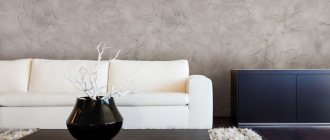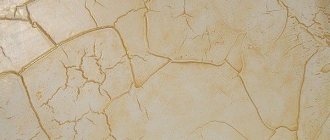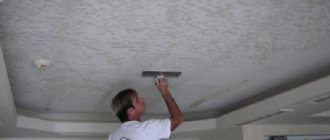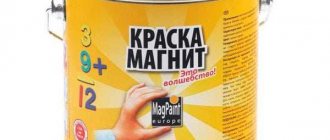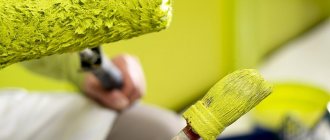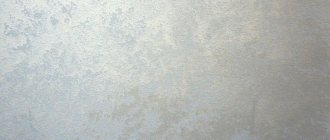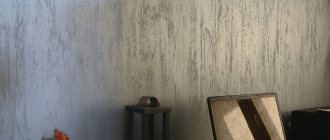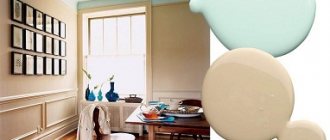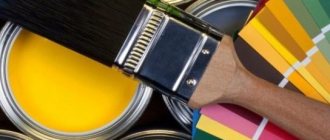The decorative effect of the coating is directly dependent on the prepared surface and the painting method. Wall decor paint can work wonders. With its help you can create an imitation of wood, silky or velvet surface.
Decorative wall paints allow you to create a unique look for your home. Manufacturers offer a choice of decorative paints with the effect of silk, with the effect of sand, with the effect of velvet, marble, granite, plaster, and precious metals (gold, silver).
Paints also come with the addition of mother-of-pearl, which results in a chameleon effect.
What is decorative wall paint and methods of applying it
Decorative paint is a paint that creates some visual effects. This group does not include ordinary opaque monochromatic compositions. Only those that are at least somewhat different from them. These compositions reproduce various natural materials. Silk, velvet, plush, sand, natural stone, leather, velor, etc. They are sometimes called decorative paints, since they are not just a background, but an independent decorative element.
Decorative wall paint with a silk effect is a decorative element in itself
Most often, decorative paint is applied as usual - with a brush, roller or spray gun. If the texture itself is “rich”, this is quite enough. The walls already look unusual. In this case, they are just background. Beautiful, unusual, stylish, but background.
Rollers with embossed relief - easy and simple way to get unusual wall decor
To obtain more interesting surfaces, special application techniques are used. The simplest ones are relief rollers. They break up the monotony of paint by adding relief. There are other methods too.
- The applied paint is rubbed off. So you can get wet silk or plush from “silk” paint.
- Partially wipe off the paint with crumpled paper, a sponge, a piece of fur, plastic or metal notched spatulas, metal wool, etc.
- They go over the top with a semi-dry roller or a hard brush with darker or lighter paint.
- Place plastic film on the painted piece, crumple it a little and remove it.
Some ways for creative design
In general, there are a lot of options.
This process is completely creative and there are a lot of variations. And the result can be very different, even if you use the same paint.
Varieties of decorative paints
Types of paints can be divided into 2 large groups:
- Having special properties . The mixtures imitate natural materials, and some glow in the dark. This category also includes mosaic compositions, the structure of which contains solid particles of different colors. When applied to a wall, such particles are distributed randomly, creating artistic effects. But paints require the use of special equipment - a spray gun with a nozzle diameter in the range of 1.8-3.5 mm.
- With a special structure . They are applied to the surface using tools such as shaped spatulas and a texture roller. More paint is applied to the surface of the painted wall, this time of a different color, and then, until the composition has dried, a roller is rolled over it or a spatula is passed over it. Partially the top layer is erased, and interesting effects are created.
There are other classifications of decorative mixtures. For example, they can be divided into liquid and dry. Many people know the second type as a type of decorative plaster, to which pigment is added during dilution to obtain the desired shade.
Liquid mixtures are sold completely ready-to-use and have the same strength and durability as acrylic paint, but are more flexible. These properties are imparted by the acrylic latex included in their composition, which polymerizes during the drying process.
Decor paint effects
As already said, decorative paint for walls reproduces certain textures of natural materials. In this case, they often talk about paint “with effect”. For example, with the effect of silk, sand, stone, leather, etc. There are many options and variations, and you can get lost in specialized catalogs. It will be a little easier if you have an idea of what you can find and what it might look like.
- Antique, patina.
- Silk, silk threads.
- Velvet and velor.
- Sandy surface.
Accent wall. This is where you can decorate it with decorative paint with an “effect” - Under decorative plaster.
- Nacre.
- Metallic.
- Leather, suede.
- With the effect of natural stone.
As you can see, the list alone is impressive. And different paints will give the same effect differently. This is due to the fact that the components and fillers differ. And the difference is sometimes significant. In general, it is usually difficult to decide. But know that whatever you choose will be interesting.
Technology and methods of applying decorative paint
Each technology is complex in its own way. The method of application has its own nuances. While plastering work is unthinkable without special rules and Venetian trowels, colorful mixtures are laid using an even wider range of devices. As a rule, high-quality painting is impossible without special tools.
Tools
How to paint with decorative paint and what is needed for this? Special rubber stencil rollers, textured sponges (sponging technology), shaped brushes, special brushes. Often, masking tape is required to achieve discrete gradients or other patterns.
Important: for an excellent result, careful preparation of the walls for application is required.
I would like to immediately make a reservation that high-quality painting is a delicate, skillful process. It is very easy to make a mistake in technology and, at best, not achieve the desired effect. At worst, you will be upset by the result of your work.
Special patterned rollers
That is why we strongly recommend using the tools, equipment and services of the masters of the CasaBella studio, and here’s why.
Advantages of the CasaBella studio
- We guarantee the achievement of any effect declared by the manufacturer. Do you need a wet silk effect for the walls in your apartment? It will flow like Arabic satin. Do you want velor? You won't be able to tell the difference between its velvety quality and the real thing with the palm of your hand. Gold will shine like the polished crown of a Monarch, and aged silver with a touch of patina will give the walls a touch of medieval mystery. Or the charm of shiny high-tech.
- We provide a guarantee for all work performed. Rest assured, the coating will last for many years. We work strictly according to technology.
- Save money while achieving perfect results. Compare the loss of your precious time and the price of an additional tool with the cost of paying for the services of CasaBella professionals and think in which case you will win. In fact, for the same amount, you get a fantastic result! Plus a guarantee!
Application surfaces
I want beauty to spread over all surfaces, penetrate into every crevice, and decorate every square inch of space. And it's possible!
- Walls. Obviously! Decorative paint for walls - this is how most owners of apartments, houses and public institutions formulate their request.
- Ceilings. Painting ceilings also poses no problems. A slightly bolder decision, congratulations! Paintwork materials also look impressive on combined ceilings that combine tension elements with recesses for lighting elements.
- Niches. Decorative coatings in niches, which are found in almost every apartment or house, look very interesting. Sometimes they are planned specifically, but most often they arise as a result of redevelopment or rearrangement of furniture.
- Bedroom alcoves. The design of the bedroom alcove also looks amazing. The bed seems to be immersed in a zone of increased aesthetics and comfort.
- Doors. An aesthetic approach to decorating your interior. With proper preparation of the door for good adhesion of the material, the paintwork on the door appears in an amazing light. Incomparable!
- Cabinets and furniture elements can also be decorated with decorative paints and varnishes. You just need to take care of the proper preparation of the top layer, and your closet will sparkle with pearlescent highlights or turn into a velvet royal wardrobe.
Decorative paint for walls with the effect of silk and silk threads
Many manufacturers have wall paint that looks like silk. If there are at least several decorative or interior paints, then one of them is silk. The look is very sophisticated and delicate. Suitable for living rooms, bedrooms. In terms of performance (acrylic can be washed with a brush), it can also be used in the hallway, but if you are satisfied with such a “refined” look of your hallway.
When choosing, pay attention to the base. Security is important for housing. The best option is silk-effect paint based on aqueous acrylic dispersion. It is relatively inexpensive (when compared with silicone, for example), washable, does not fade and can be painted in all colors. Many decorative paints are made on this basis. To obtain paint with a silk effect, a special type of mother-of-pearl and pigment are added to it.
This is what interior silk paint looks like on a wall
Paint consumption is average, you will have to paint in at least two layers. This is for low absorbency or pre-priming. The absorbent surface will require three coats exactly. And paint is not cheap, so it’s better to prime it. If the paint is based on acrylic dispersion, then we use acrylic primer. But it's better from the same company as the paint. There will be no problems with product compatibility.
The disadvantage is that the surface to be painted must be flat. Almost perfectly flat. The second point is that if you want to get “exclusive”, you need to master the application technique. You can, of course, just roll it out with a roller. It will work out well too. But it could be more interesting.
You can wash it with detergent (not abrasive), a rag or a brush. This cleaning does not affect the appearance. In the sense that it is not getting worse. Where the walls are frequently touched, “glossy” areas may remain. If you want this type of finish in your hallway, consider a varnish finish. But this type of paint “breathes”, so if you varnish it, you will lose this effect.
Each company that produces silk-effect decorative paint has a slightly different appearance. Some have multiple options. And not colors, but textures
If you think that silk effect paint looks the same from all manufacturers, you are mistaken. They use different additives, resulting in slightly different surfaces. This type of decorative paint is popular, so some have several paints that give different textures. There are also different application techniques. With their help, you can get different types of surfaces: classic, wet and crushed silk.
Paint decor? Yes, and what another!
Decorative paint is obtained by using various additives and is usually used for finishing decorative finishing of interior elements and furnishings. The difference from ordinary paint is its greater viscosity and density, which is formed when special substances are added, which give the coating originality. The use of such paints will allow you to obtain the texture or pattern desired by the decorator. In addition, decorative paints do not just add color, but provide scope for the flight of decorative imagination. And in the end, the result is determined by both the method of application and the thickness of the paint layer. The creation of textured surfaces is done using special rollers, sponges, spatulas, imagination and patience. So a skilled decorator with a wide color palette of modern paints is able to create interiors that are truly unique in their individuality.
When applied skillfully, a layer of decorative paint will retain its brightness and color for a long time. If you compare it with regular wallpaper, it’s twice as much. Further, most high-quality paints are completely safe for human health, since they are made from natural ingredients. Waterproof paints will make it possible to choose a material for rooms with high humidity.
Sand or sand dune effect on walls
The composition of sand-effect paint includes binders, solvents, antiseptics, and crystal dispersions. When applied, we get shimmer, and after drying the texture appears. With different application techniques we get different looks - dunes, dunes, sandy overflows.
The effect of sand and sand dunes is created using special decorative wall paint
The paint is easy to apply and no special techniques are required. Due to the pronounced texture, minor wall defects are hidden. So the requirements for the surface are not so stringent.
Application and operation
The paint is easy to apply; no complicated techniques are required. Unless you want to have not just “sand”, but dunes. But to create such an effect, special compounds are required.
It is not possible to wash sand effect paint with a brush. Gentle cleaning with soft attachments on the vacuum cleaner. And keep in mind that if you touch a wall painted with sand effect paint, the relief will crumble. But this is invisible and does not affect the appearance. The surface is initially heterogeneous, the relief simply changes slightly. The view does not suffer from this. The service life is up to 10 years, which is not bad at all for paint.
Please note the availability of hygiene certificates for this type of paint. The binder is not always harmless. So having certification and a certificate from the sanitary inspectorate about the amount of substances released is simply necessary.
Advantages and disadvantages of modern decorative compositions
Most compositions for interior work have many advantages:
- Environmental Safety. Such paints can even be used in children's rooms.
- Variety of decorative effects. This is a wide selection of colors, the ability to create textured patterns. The final version even depends on what tool was used for application - a roller or a spatula.
- Resistance to aggressive influences (no matter mechanical damage or direct sunlight). In addition, mold does not grow on such surfaces.
- Good vapor permeability, thanks to which it is possible to create an optimal microclimate in the room.
- Durability. The average service life is 10 years, while even the highest quality wallpaper has to be replaced earlier.
- The ability to quickly renew the coating by simply applying a new layer of paint over the old one, without prior surface preparation.
- Easy to care for painted surfaces. Most compositions belong to the washable category. This is recommended for those areas of the walls that are subject to heavy loads (for example, in the area of sockets, lamps and switches).
Many types of paint allow you to create a coating with antistatic properties, due to which less dust settles on the walls.
Decorative paints are practically free of drawbacks. The argument against their use for interior decoration is the high price. And to this should be added the high consumption of material. The mixtures are applied in different ways, but on average the consumption can reach 1 kg per 1 sq. m. This increases the cost of painting the walls. In addition, although mixtures allow you to experiment with texture, this does not mean that you can ignore the preliminary preparation stage. Still, the walls need to be leveled.
Please note: Textured ceiling paint
Structural paint with sand for decorative plaster
This type of coating is similar to decorative plaster. But the paint has a more liquid consistency, so it is applied in a thin layer with a roller or brush, and sometimes spatulas are used. But this is not necessary, and they are also used to obtain relief on the surface. Structural paints with sand are based on an acrylic water dispersion with fillers of various sizes.
Structural paint for interior work gives a surface that is similar to decorative plaster
Paint with the effect of decorative plaster can be painted in bulk; the base color is white. It can be used in a single-color version, but it is possible to make a two-tone coating. To do this, apply structural paint as a base. After it has dried, paint of a darker or lighter tone is applied with a semi-dry roller or brush. It can be matte, glossy or with some effect. There are options. The so-called “glaze” is obtained.
Assortment, types of effects and use of decorative paints
Decorative paints, which are used for interior decoration of residential walls, are virtually no different from other similar materials. The only difference is that decorative paint intended for cladding surfaces has a thicker consistency and the presence of various small particles. Namely, they form an attractive, stylish wall decor (mother of pearl, silk, flakes, velor, metallic, gold) and allow you to embody the most daring, sometimes non-standard design ideas in wall decoration. Another significant difference is the method of application.
Traditional decorative paints that modern colorists work with can be identified in a separate list.
· Silicate. They are made using colored pigments and liquid glass solution. They are practical, durable and are mainly used for decorative exterior decoration.
· Acrylic decorative paint. Thanks to the acrylic resins present in the composition, decorative paints with a variety of effects are durable and elastic. They have increased resistance to excess moisture and abrasion.
· Adhesive. Basic components: casein, alcohol, aqueous solutions, starch, cellulose, and other substances. This decorative paint is breathable due to its porosity.
· Latex. They are in a high price range. They are resistant to all kinds of damage and fading. They look quite original and are applied in a thin layer.
· Water-based decorative paint. Base: pigments, water, binding elements. When decorating walls, water evaporates and a polymer film forms. The surface with such a decorative coating can be washed.
· Alkyd (oil, enamel). They take a long time to dry and have an unpleasant odor, but are wear-resistant, resistant to weather precipitation and fading. Must be diluted with solvents before use.
The last type of paint and varnish products is recommended for use in exterior facade decorative work.
Velvet and velor - the next effects
The reproduction of velor and velvet surfaces is quite reliable. Paints with the effect of velor and velvet (Projekt 04 - Project 04) are made on the basis of acrylic water dispersion, adding particles to it, which create the effect of a fleecy surface. The walls themselves remain smooth. To obtain an evenly painted surface, it is recommended to apply with a spray gun. If you like “crushed” velvet and velor, you can use a brush or roller.
Paints with velor effect - muted shine and apparent velvety
Walls painted with velor effect wash well, do not fade for a long time and do not change their appearance. They can only become shiny from frequent touching. Therefore, it is better to use them for residential premises, not for corridors and kitchens.
Decorative paint for walls with mother-of-pearl: application features
Paint with a pearlescent effect is usually made based on an acrylic water-soluble copolymer. This means it is safe. The light, unique shine of mother-of-pearl cannot be confused with anything.
The main thing is application technique
And if you want “gold” or “silver” wall paint, but not provocative, then you will most likely like pearlescent paint in a suitable shade. Another option is silk. Slightly different look, more subdued shine. But you need to see it all. Even in the photo you can't show the difference.
Colors and additives
There are enough shades and colors of decorative paint with a mother-of-pearl effect. They usually sell a concentrate that is diluted with water. For one part of concentrate take 6-8 parts of water. The intensity of the shine depends on the amount of water.
If you add microfibers, you can hide wall defects
Flocks and glitters can also be added to the base composition - white or colored inclusions, small fibers, sand, multi-colored crystals, sparkles. Candis and San Marco have such options. There are also varnishes with mother of pearl. They can be used to coat base paint and create an abrasion-resistant pearlescent surface.
Application Features
But working with pearlescent paint is not easy. It is especially difficult to obtain a uniform pearlescent sheen over the entire surface. This is not an easy task. Even the masters can’t handle everything, and it’s better not to try it yourself. You will only waste an expensive product.
But if you want to get pearlescent stripes, waves, stains - no questions asked. True, you need to practice first, since the application technique greatly affects the appearance. The tool used to apply the pearlescent paint also has an effect. Some types are applied in one layer, others in two. Read the description.
Those that are applied in two layers do not mean “bad”. They give you more options. The first one can be considered basic. It creates the background. But the second is to draw the relief. You can use a roller with a structured “coat,” a spatula, or brushes with bristles of varying hardness. In general, there are many options. But you will need to reproduce all the movements almost exactly. So it takes training. Or a good master. But also ask him to show a sample in a small area, and only then agree or not.
This paint can be applied as a second layer to the structural one. If you use a translucent one, you can only get a slight lightening of the color in the texture and a characteristic shine. Or you can go a few shades darker/lighter or, in general, apply paint of a different color with light strokes.
Stone effect paint
Another decorative paint, in appearance very similar to decorative plaster. This is a stone effect paint. It is safe as it is made on the basis of acrylic emulsion. Decorative elements are added to it, which create the required appearance and relief. For example, Rust Oleum Multispec Stone Accents, Siberia Rock`n`Wall. This paint has 10 shades - from very light to quite bright. Can even be used in kitchens on work aprons.
Both natural stone effect paints look about the same
A very good specimen in terms of performance properties. Has very good adhesion. Very smooth surfaces - such as plastic - require a primer. The rest can be painted immediately. It is applied from a spray gun or using a special roller (from the same company). Appearance depends on the method of application. After the roller, a surface with clearly defined flakes of “stone” remains. After the spray gun the surface is smoother.
This stone-imitating paint is easy to use and durable. It can even be washed with a brush. For Rust Oleum, application of additional protection (in the form of varnish) is not required, but in areas of heavy pollution it is better to coat Siberia with varnish. The paint is repairable. If you get a bald spot or a chip somewhere, you need to moisten a piece of sponge with water, squeeze it out and dip it in the paint, apply it to the desired place and wait until it dries.
There are also stone paints in cans. But you are unlikely to use them to paint walls. Perhaps for a panel or some kind of decoration. It's too expensive.
This is what the stone paint “Alatyr stone” looks like
Another type of surface is provided by paint with the effect of burnt stone Alatyr-stone. It is also called “liquid granite”. Apply by spraying through a spray gun. There are single-color and multi-color options. Less shiny than the ones described above. Positioned as resistant to cracks and ultraviolet radiation. After drying it must be varnished.
Textured paint for interior decoration: features of use
To decorate the interior of living rooms, you can use any textured paint intended for interior decoration.
Most often, preference is given to acrylic and silicone compounds. However, it is also possible to use mineral compositions. When decorating the interior, not only the entire walls or ceiling, but also individual zones can be decorated. Using these compositions, columns, pilasters or beams are formed. We offer you to look at interesting solutions that were used in the design of various rooms:
Textured paint for exterior use
Manufacturers offer a wide range of products for facade finishing. When choosing a suitable option for outdoor work, you should pay attention to compositions based on:
- vinyl. The binder is plastic or vinyl filler. This material is only relevant for outdoor work. The formed coating exhibits low permeability, but at the same time has high adhesion. Can be applied to any substrate, protecting them from negative external influences. The composition is difficult to work with;
- acrylic. Large range of colors. Easy to apply. Possibility of forming intricate reliefs. The coating is exposed to ultraviolet radiation;
- silicone Modern textured paint is used to form a durable, vapor-permeable coating that protects the base from moisture and other negative factors. Helps disguise defects;
- polymers or silicates. Liquid glass is the main component used in the formation of paint and varnish coating on the facade. With high vapor permeability, it demonstrates good adhesion to the base. Repels pollution, protects against external factors;
- mineral components. The basis is cement. Due to low resistance to temperature fluctuations, cracks may appear on the surface after winter, which limits its use in façade design.
Decorative paint for walls in the interior: photo
Seeing what effect paint looks like on a piece of cardboard or on a screen is one thing. But imagining how it will look in the interior is completely different. To make the task easier, we have collected several photos of interesting interior solutions. As a recommendation: if you are going to cover all the walls, look towards very light shades. Bright and dark ones are used to decorate accents. These are accent walls, dedicated zones. In general, see for yourself.
Through one color another “shines through” - one of the techniques
And some people call gray color boring. We need to play him right
Bright color - only on one wall. It is also repeated in some small details or has a companion color. In this case, the second option is chosen - floor color
Different application techniques give different looks. Here we use chaotic movements with a narrow spatula on a freshly painted surface
This is the result of rolling with a relief roller. Non-standard
The effect of cracked old paint. Very interesting, but requires an appropriate interior
Ordered chaos. This can be called the principle of drawing these lines
Triple effect: silk, two colors and stripes
This can be done from paint with mother-of-pearl, silk effect or velvet/velor, metallic

